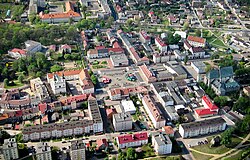Wielun
| Wieluń | |||
|---|---|---|---|

Old town in Wieluń
|
|||
|
|||
| Coordinates: 51°13′21″N 18°34′26″E / 51.22250°N 18.57389°E | |||
| Country |
|
||
| Voivodeship | Łódź | ||
| County | Wieluń County | ||
| Gmina | Gmina Wieluń | ||
| City rights | 1283 | ||
| Government | |||
| • Mayor | Paweł Okrasa | ||
| Area | |||
| • Total | 16.9 km2 (6.5 sq mi) | ||
| Population (2006) | |||
| • Total | 24,347 | ||
| • Density | 1,400/km2 (3,700/sq mi) | ||
| Time zone | CET (UTC+1) | ||
| • Summer (DST) | CEST (UTC+2) | ||
| Postal code | 98–300 | ||
| Area code(s) | +48 43 | ||
| Car plates | EWI | ||
| Website | http://www.wielun.eu/ | ||
Wieluń [ˈvjɛluɲ] (German: Welun) is a city in central Poland with 24,347 inhabitants (2006). Situated in the Łódź Voivodeship (since 1999), it was previously in Sieradz Voivodeship (1975–1998). Wieluń has a long and rich history. In the past, it used to be one of the most important urban locations of the , and the capital of the Land of Wieluń (Ziemia wieluńska). Several Polish kings and notables visited the town, but following the catastrophic Swedish invasion of Poland (1655–1660), Wieluń declined and never regained its status. In September 1939, during the Invasion of Poland, it was bombed by the Luftwaffe. The Bombing of Wieluń is considered to be one of the first bombings in Europe in this war. It killed an estimated 1,300 civilians, injured hundreds more and destroyed 90 percent of the town centre.
Wieluń is an important road junction, the town also has a sports club WKS Wieluń, established in 1957 after a merger of two earlier clubs. In the past, WKS Wieluń had several departments, such as track and field, basketball, table tennis, handball and association football. Currently, the only remaining department is football.
Wieluń was first mentioned in a 1282 document as Velun (in 1283: Vilin). The exact origin of the name has not been explained. Historians claim that either it comes from a Slavic word "vel" (which means a wetland), or from a given name Wielisław. Jan Długosz wrote that Wieluń was located in the area abundant with water, which may mean that the former theory is correct.
The Land of Wieluń (Ziemia wieluńska, Velumensis Terra) was a historic land of the Kingdom of Poland and the Polish-Lithuanian Commonwealth, which for centuries was part of Sieradz Voivodeship, Province of Greater Poland. It was based on the medieval Castellany of Ruda, which was established in the 10th or 11th century. The Castellany of Ruda was first mentioned in the 1136 Bull of Gniezno, and during the period known as Fragmentation of Poland (see Testament of Bolesław III Wrymouth, it was part of the Seniorate Province. In the late 12th century, the Castellany was acquired by Duke Władysław Odonic, and in 1217 it became property of Władysław III Spindleshanks. Later on, it was ruled by the Dukes of Silesia from the Duchy of Opole, and in the second half of the 13th century, returned to Greater Poland. In 1281, the castellany was moved from Ruda to Wieluń, and since then, it has been called the Land of Wieluń.
...
Wikipedia



